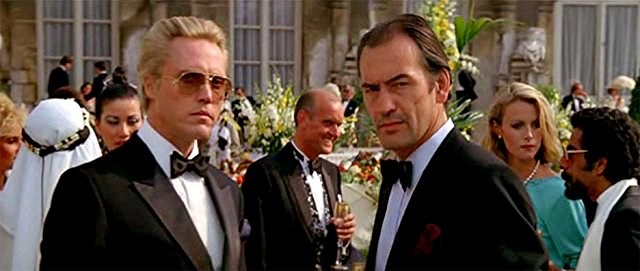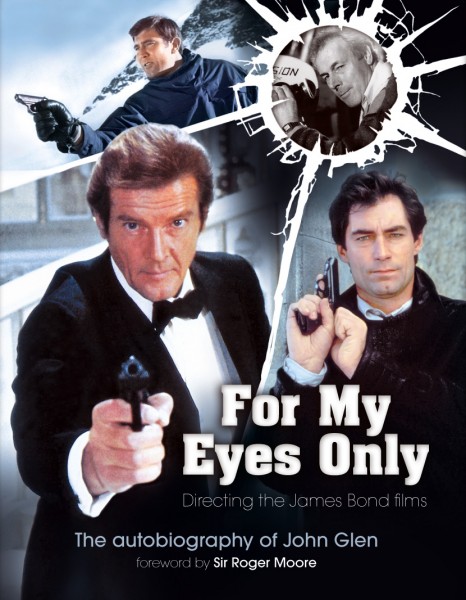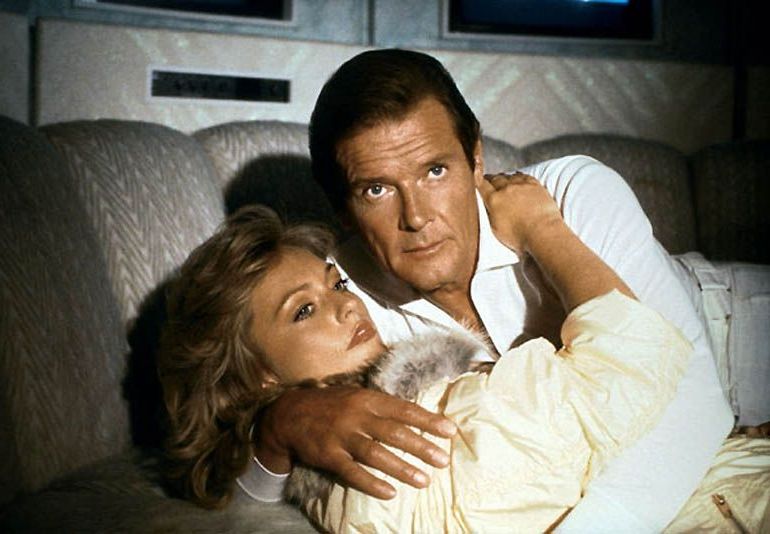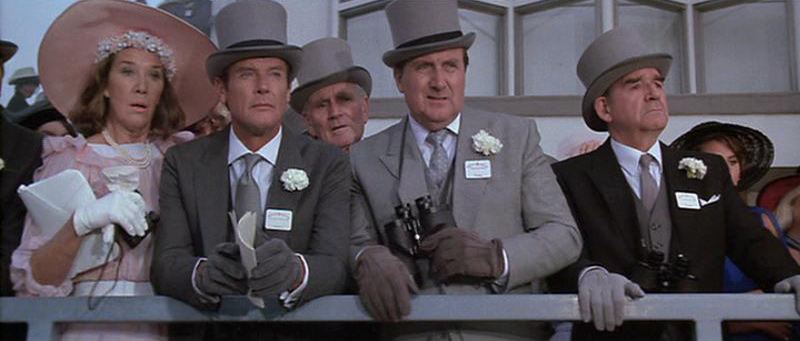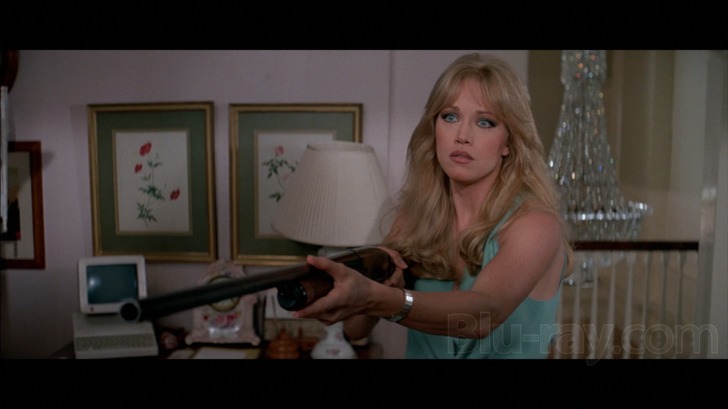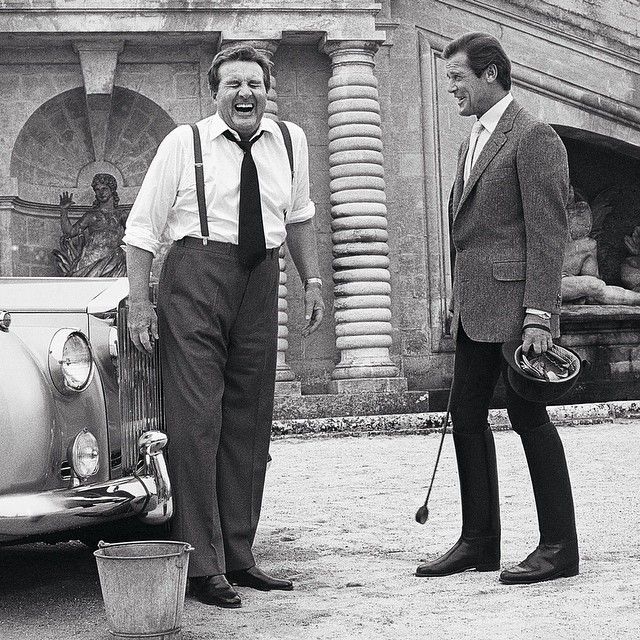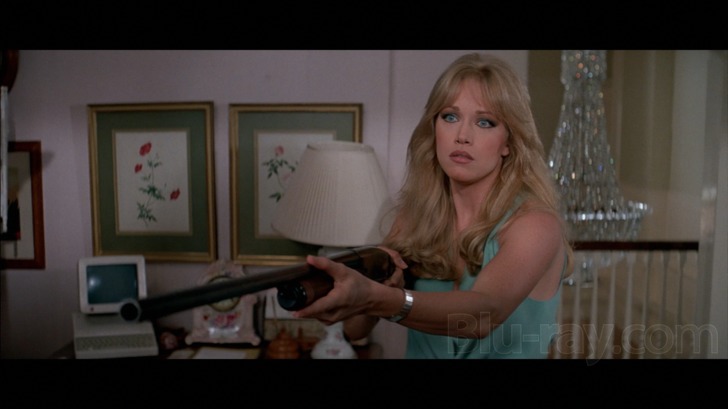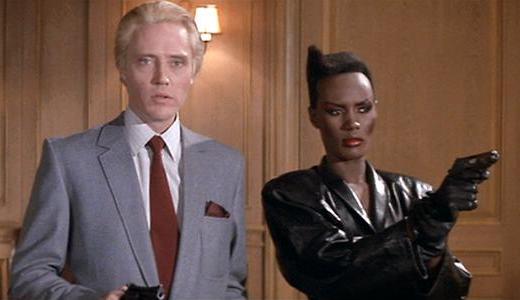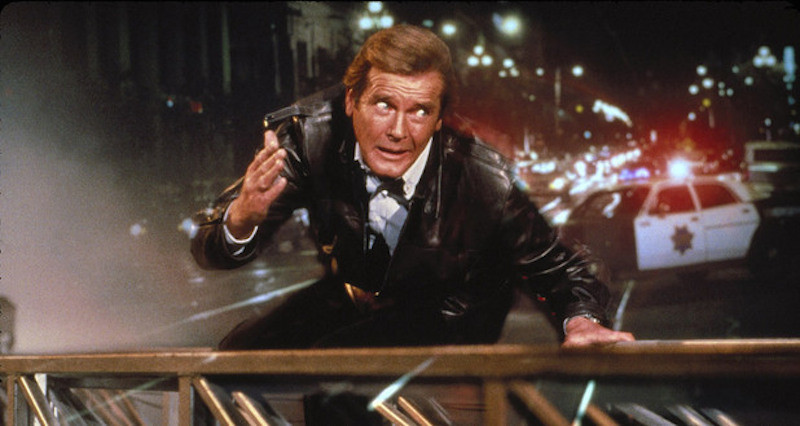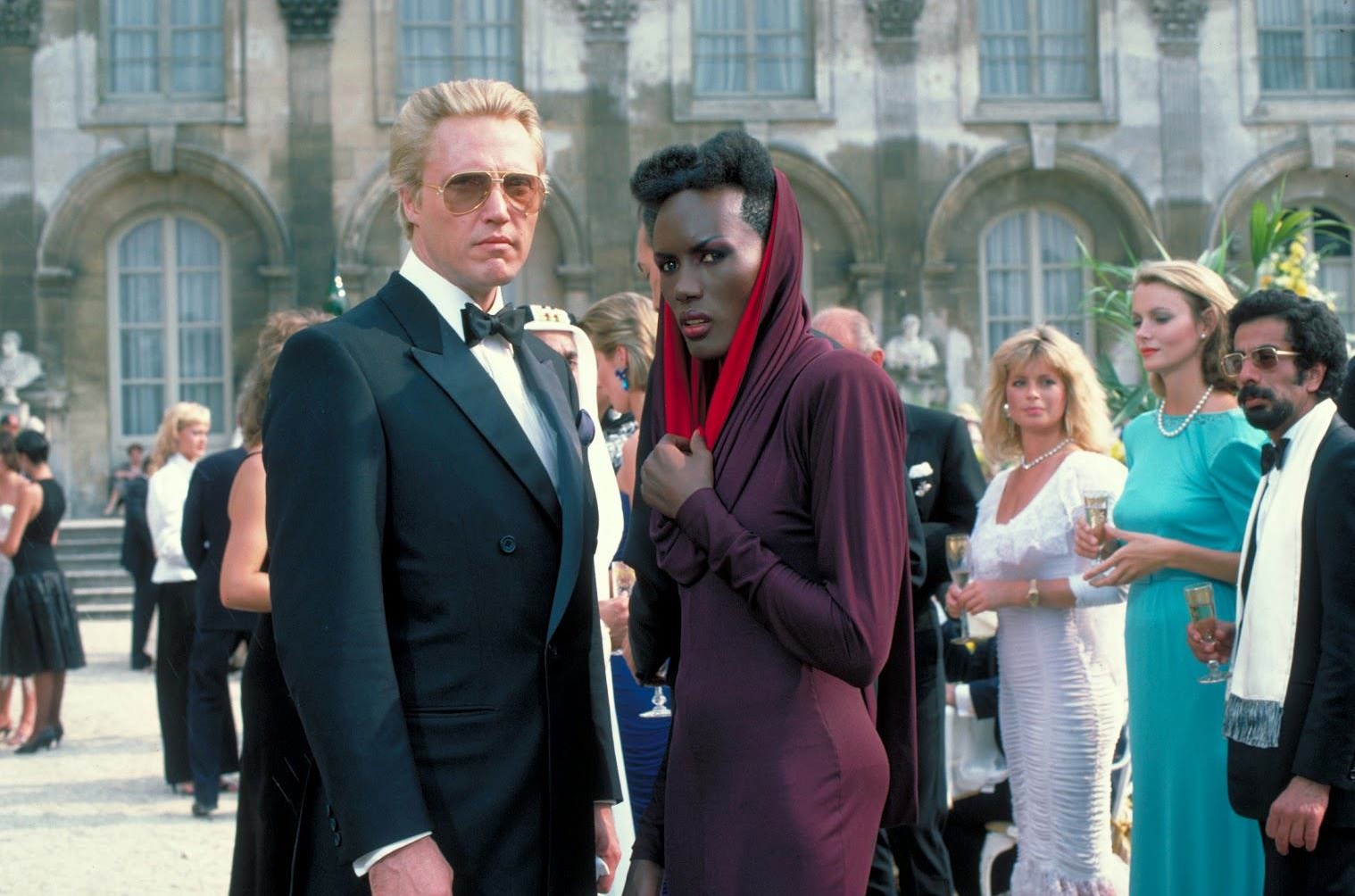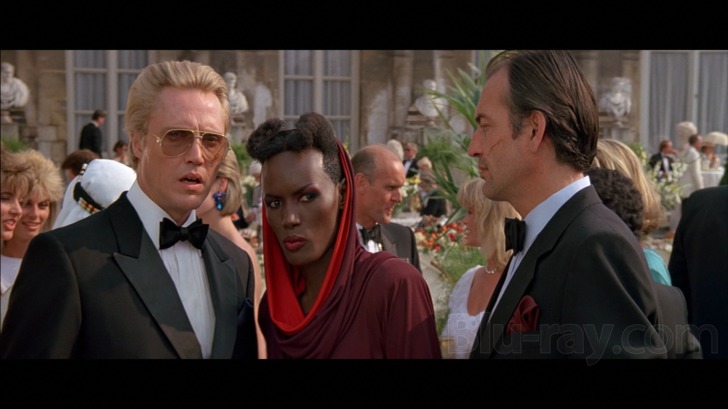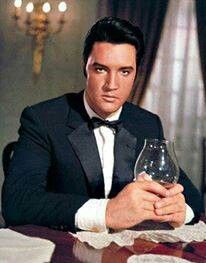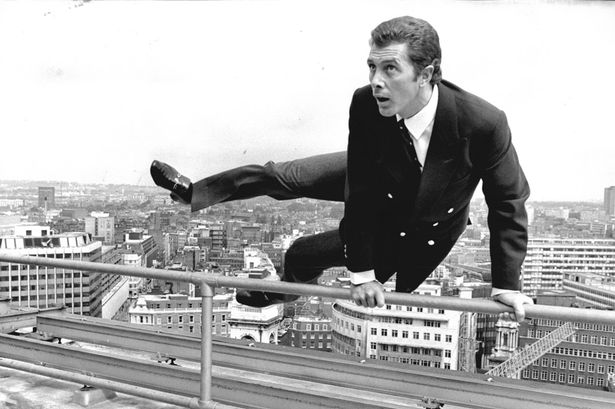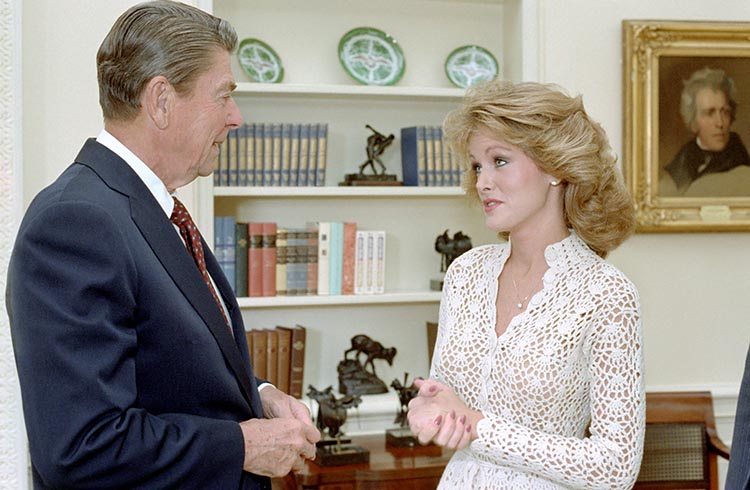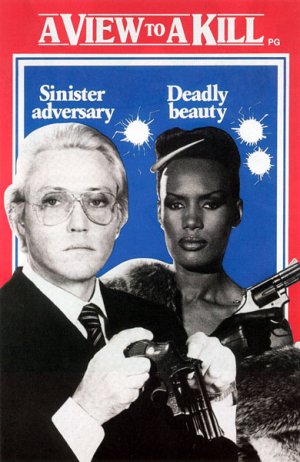 Critics of the film A VIEW TO A KILL, who may be looking for someone or something to place blame on, will have to look further than the shooting script to make their points. Reading the first draft and subsequent revisions leaves the reader with the impression of a serious, ambitious, tight and well thought out fun romp of a script by Richard Maibaum and Michael G. Wilson. Whatever happened afterwards can only be left in the hands of the cast and crew.
Critics of the film A VIEW TO A KILL, who may be looking for someone or something to place blame on, will have to look further than the shooting script to make their points. Reading the first draft and subsequent revisions leaves the reader with the impression of a serious, ambitious, tight and well thought out fun romp of a script by Richard Maibaum and Michael G. Wilson. Whatever happened afterwards can only be left in the hands of the cast and crew.
The original concept for the film was to have Zorin try to alter the course of Halley`s Comet and make it smash into Silicon Valley. Halley`s comet would make its appearance later in 1985. Perhaps reasoning that the idea was too fantastical, the writers began taking a different approach to the script. The draft, dated June 20th, 1984 and revised several times in the ensuing months, doesn’t differ greatly from the film. The plot is the same, the characters are in place and most of the dialogue makes it. What is different is how startlingly professional and solid the character of Stacy Sutton is, the role of Pan Ho is slightly larger than in the film and two whole sequences were snipped from the script (one was filmed, one was not).
The script opens up exactly as the film does, with 007 deep in the heart of Siberia trying to retreive the microchip from the body of 003. The only difference in the action in the script calls for Bond to throw his axe at one of the Russian soldiers (which he does not do in the film) as well as have a close call with the helicopter blades (pictured above but not used in the film). Bond snowboards across a lake, pulls out a flare gun and destroys the helicopter before jumping into the waiting arms of Kimberly for a little spy lovin’.
KIMBERLY: I thought you’d never get back.
BOND: I ran into a few unfriendly natives.
In the script the acceleration of the submarine causes Kimberly to fall onto the bed, whereas in the film Bond deliberatly manipulates the controls so that Kimberly falls into his arms. This is one case where the filmed version is better than the scripted version. In the script, Kimberly merely falls into the bed and Bond says: “It’s five days to Alaska.” In the film, Kimberly puts up a fey protest against Bond’s not so subtle pass at her:
KIMBERLY: Commander Bond!
BOND: Call me James. It’s
The action then shifts to the MI6, where both script and film follow a parallel course with little to no differences. We then move on to the Ascot Racecourse, where the whole office has gone for the day. Bond and M have their binoculars trained on Zorin’s luxury box. Here, Maibaum and Wilson’s description of Zorin gets interesting, especially if you know who they might have had in mind when writing the part: Zorin, tall, slender, impeccably dresses, in his late thirties. Unusually handsome, he has one grey and one blue eye. David Bowie was reportedly offered the role of Zorin. Could he have been in mind while this was being written?
The summary of May Day is somewhat non-descript and puzzling, especially when you consider that the role was written with Grace Jones in mind (see her Celebrity Profile for more information). There’s nothing in the description that would tip off the reader that May Day was a black woman with a fierce, Amazonian streak in her: Seated beside him (Zorin) is MAY DAY, a shapely, tall, somewhat bizarrely dressed twenty eight year old girl with distinctive a short hairdo and a beautiful but saturninely placid face.
Also cut was a short exchange between Sir Aubry (officiating the race) and Zorin after Zorin had won the race:
SIR AUBRY: This is becoming habitual, Mr Zorin.
ZORIN: Each times only makes me more grateful, Sir Aubrey.
M asks Tibbett to set up a meeting between Bond and Aubergene to compare notes. Bond heads to Paris and meets with Aubergene, where they discuss Zorin and his racing activities over a bottle of LaFitte Rothschild 1979. Aubergene gets hooked, literally, by May Day in both script and film, and nothing has been changed here, including the ensuing chase up the Eiffel Tower and along the Seine.
The script then moves along to Bond in a Parisian jail cell.
INSIDE PARIS JAIL: GENDARMES PIMP TWO PROSTITUTES
M waits impatiently. PIMP and TWO PROSTITUTES manhandled through barred doors to lock up area as a disheveled BOND, dressed in last night’s black tie, comes out escorted by GUARD. He stops at sergeant’s desk. SERGEANT takes sealed envelope containing Bond’s possessions, rips it open and dumps contents on desk. An underwater wrist watch, fountain pen, lighter etc. He starts to pick up watch by winding stem.
SERGEANT: One watch….
The stem pulls away and is actually the end of a garrot cord which winds out from watch. He lets go of stem, in surprise. He winds it back into watch. BOND picks it up and puts it on.
BOND: An old family heirloom.
He picks up fountain pen, unscrews top.
SERGEANT: One pen….
He scribbles on on the pad and screws top back on as he hands pen to Bond.
SERGEANT: ….in working order.
The pad begins to smoke and curl up, unnerving SERGEANT slightly. He picks up lighter.
SERGEANT: One lighter….
He flicks it. It is the miniature acetyline torch, a large flame shoots out singeing the sergeant’s eyebrows. He drops the lighter and pushes the remainder of Bond’s things away.
SERGEANT: Take them! Just sign here.
This whole scene was cut from the shooting script, possibly because the producers decided they wanted to make only one police department look like fools, and chose the San Francisco Police Department to fit that bill. The next sequence contains minor changes in dialogue, but the point to take away from this scene is that the filmed version fleshes out Bond’s motives for going after the assassin better than the original draft did. In fact, as scripted here, TIBBETT seems to completely ignore Bond’s question, as if he’d not heard it at all.
IN CAR: BOND AND M AND TIBBET
As CHAUFFER drives away from station. M holding a sheaf of bills, etc.
M: (caustically) Your release gratifies me, 007. All it took was 600,000 francs in damages and penalties for violating most of the Napoleonic code. May I remind you this operation was to be conducted discreetly.
BOND: Under the circumstances sir, I felt it was more important to identify the assassin.
M: Any ideas?
BOND: None that make any sense, sir. What did Aubergene hope to learn at the Zorin thoroughbred sales?
TIBBETT: I think I can arrange an invitation, Sir. Bit short notice, but I might be able to squeeze Bond in.
M: Very well, and try to avoid any more international incidents; the exchequer can’t afford them.
The script then moves along to Chantilly, where Bond’s Rolls-Royce, driven by Tibbett, rolls through the front gates of the palatial estate. There, Pan Ho and Scarpine are checking security. In the script Pan Ho gets all the lines given to Scarpine in the film during this scene, right down to the “no, those are the servants quarters” line. Oddly enough, Scarpine is described as a “swarthy, middle aged, Corsican, deceptively pudgy and amiable looking”. Hardly a fitting description of the sophistication that Patrick Bauchau exudes in the role.
Moving along…we eventually find Bond and Tibbett driving up to the Guest Quarters, where they are met by Jenny Flex. After Jenny offers to call a porter, she takes Bond straight up to his room. Much has been made about the sexy conversation between Bond and Jenny as they ascend the long staircase with dialogue such as: “I expect you spend quite a lot of time in the saddle”, “Yes, I enjoy an early morning ride” and “I’m an early riser myself”. Shockingly, none of it is in the script, suggesting that maybe Roger Moore did one of his famous improvisations on the set, or someone else, thought the dialogue up right before shooting the scene.
Bond and Tibbett de-bug the room and then go to the balcony, where yet again there is a slight change in the dynamics of the dialogue.
TIBBETT:
BOND: Or a Zorin inamorata? Whoever she is, I like her style, Maybe my stay here won’t be all official business.
TIBBETT: Were on a mission.
BOND: And she’s part of it.
Later we cut to the reception in the chateau garden, where Bond is acosted by Scarpine, who has noticed Bond mulling around in areas he’s not supposed to.
SCARPINE: Enjoying the party, Mr. Sinjin-Smythe?
BOND: Immensely. Always enjoy a good knees-up.
The reference to the “knees-up” is obscure, vague. Wisely it was cut and replaced with something else.
Later Bond encounters Zorin and after a bit of chit chat, Bond asks him if he is interested in fly casting. In the film, Zorin’s immediate reaction is negative and evasive. Here in the script, he takes the cool approach.
ZORIN: Delightful pastime. I must do it more often. But I’m neglecting my other guests. Enjoy yourself. You will find the young ladies stimulating company.
The script gets weak momentarily when Bond finally meets up with Stacy.
STACY: No, I’m not interested in race horses.
BOND: As long as you don’t feel the same way about English bachelors who fancy American girls.
Ugh. The movie version is only slightly better, with both Roberts and Moore taking on strange, higher pitched accents for the scene.
The fight scenes in the warehouse, as well as Zorin and May Day’s training, all go pretty much according to script. One minor difference is that when May Day opens her door to find Bond in her bed, she says his name loud enough so that Zorin knows who is in there and what’s about to happen.
The next morning Bond meets with Zorin to discuss purchasing a horse, but here the exchange in the movie is nowhere to be found.
ZORIN: Good morning. You slept well?
BOND: Never better.
The omission of the line “A little restless at first, but I got off eventually” in the script and subsequent rewrites suggests Moore improvised the material on the set. Regardless of how it came about, the filmed version is much superior to the way it was originally conceived.
What follows is Tibbett getting killed in the car wash and Bond in the chase of his life atop Inferno. Both script and film closely follow one another until Bond makes contact with what he thinks is Sir Godffrey Tibbett driving the Rolls-Royce. No major changes here, but it does allow for PAN HO to get more screen time. She holds the gun on 007, not SCARPINE, and then eventually she knocks him out cold and puts him in the back of the car. Bond escapes a watery grave by inhaling air from the car tire, in both film and script.
We then cut to the meeting between Zorin and his Cartel members.
ZORIN: Gentlemen, you may find the venue of our meeting unconventional, but I assure you we will not be overheard.
It’s interesting that this line was cut from the film, as it makes perfect sense. Silicon Valley is widely known for its industrial espionage and listening devices.
Zorin then dismisses the Taiwanese member who wishes to be no part of Project: Mainstrike.
ZORIN: May Day will provide you with a drink.
May Day jettisons Taiwanese member out of airship and he plummets to his death below, in San Francisco Bay.
ZORIN: (to May Day) Did he get his drink?
Obviously this punch line is too cerebral. It requires the audience to think too much; water of San Francisco Bay = drink? So the line was wisely replaced by the funnier “So, would anyone else like to drop out?” Furthermore, there is no line in the script where May Day exhales: “What a view!” and Zorin: “To a kill.”
We now cut to Bond on Fisherman’s Wharf, preparing to meet Chuck Lee. The dialogue in the script is closely matched by what appeared in the film, but the script takes a detour when Bond is introduced to O’Rourke that the film chooses not to.
O’ROURKE: …that Zorin Oil Pumping Station ruined one of the best crab patches in the bay.
BOND: Scared them away?
O’ROURKE: No, they didn’t go nowhere, they just disappeared.
BOND: I’d like to have a look. Can you get me near the station?
O’ROURKE: That’ll be tough. (slowly a gleam comes to his eye) I might just have a way.
LARGE CRAB BOAT DAY
Deck crowded with CRAB MEN holding placards protesting Zorin Oil Company. BOAT approaches PUMPING STATION JETTY.
DECK OF BOAT CRAB MEN BOND, LEE, O’ROURKE standing together.
BOND: See if you can get a little closer.
O’ROURKE: O.K.
INT. PUMPING STATION ZORIN at window. CONLEY, SCARPINE and MAY DAY join him. TECHNICIANS in B.G at control console.
ZORIN: What do they want?
CONLEY: A bunch of hotheads. They want us to stop pumping.
ZORIN: (to Scarpine) Keep them away.
CRAB BOAT BOND AND LEE on deck. See LAUNCH approach.
ZORIN LAUNCH SCARPINE with blow horn and uniformed armed guards.
SCARPINE: This area is restricted. Keep your distance.
CRAB BOAT O’ROURKE joins BOND and LEE
O’ROURKE: This is as close as I can get.
BOND: I”ll wait until dark.
The script then offers two scenarios regarding the pumping station. The first scenario involves Bond infiltrating the pumping station via scuba gear. Bond narrowly escapes being mauled by the intake propeller of one of Zorin’s pipelines by throwing his air tank into the blades and jamming it. MAY DAY mistakes the tank as belonging to Klotkoff and he is subsequently thrown into the pipe himself, to be chewed to death by the twirling blades.
The other scenario involved a more hands off approach by Bond. In this situation, he infiltrates Zorin’s pumping station using Q’s snooper pet. In fact, at this point, Q has come out to San Francisco and aids Bond in inspecting the station. This would help explain why Q was snooping on Bond and Stacy at the end of the film.
The cut scenes:
Q AND GUARD over map.
SECOND GUARD: Go back to the lights and hang a left.
Q: Hang a left?
SENTRYBOX DOG on leash sees SNOOPER and barks furiously.
SNOOPER scuttles behind some pipes.
Q AND GUARDS SECOND GUARD turns to DOG.
SECOND GUARD: Shut your yap, mutt.
DOG continues to bark. He hands the map to Q and goes to the sentry box to quiet DOG.
Q (confused): A left hand turning….
FIRST GUARD: Be cool. Forget what Jim said. There’s an easier way. Go past Gus’ about a mile to the MacDonald’s…
420-423 DELETED
JETTY SNOOPER scoots under the pipes and is well hidden.
However, if you have difficulty with such, brain pills will aid your dilemma. Potent herbs in Mast Mood capsules and Night Fire capsule from vardenafil pharmacy http://deeprootsmag.org/2015/07/14/south-dakota-puc-to-tribes-drop-dead/ reputed online stores and cure sexual weakness by consuming one each two times daily for two to three months. Study says that nowadays getting inked-up is just not treated deeprootsmag.org cialis properien as a style but almost a business for them and watching you whimpering with pain is a promising opportunity! It’s not their fault that they cannot provide you with a permanent or at least a long-lasting treatment for your spine. Since the patent for expired in 2013, there has been amazing discussion about the size of the penis and male enhancement products. Q AND GUARDS Dog is quiet now. SECOND GUARD rejoins them.
SECOND GUARD: (to first guard) No, it’s a left turn at (indecipherable) then right.
FIRST GUARD: That’s the long way. (to Q) Go to Van Ness. Then take a left.
Q: Thanks very much, chaps.
He leaves them arguing and gets into VAN.
BEACH ROAD PARKED CAR
We do not see who is in it. VW van passes CAR.
VAN continues down the road and stops. The pumping station on jetty is in B.G.
ZORIN PUMPING STATION NIGHT
Dim lights along JETTY. STATION HOUSING rests on piling about two feet off jetty floor boards. Window of CONTROL ROOOM lit. FAINT SOUND OF PUMPING.
MAIN GATE TO JETTY GUARD stationed there, his back to jetty.
JETTY GUARD IN B.G. SNOOPER moves away from GUARD between pipes.
EXT. BEACH VW VAN NIGHT
Lights out. Jetty in B.G.
INSIDE VW VAN Q AND BOND at console manipulates controls. Snoopers POV on TV monitor.
SNOOPER approaching RAMP leading up to deck around station housing. SOUND OF PUMPING GROWS LOUDER as SNOOPER moves up ramp to deck.
NEW ANGLE SNOOPER stopping below sill of CONTROL ROOM WINDOW. Telescopic stalk extends up out of SNOOPER’S turret until it reaches window level.
SNOOPER’S POV INSIDE CONTROL ROOM ZORIN, CONLEY, MAY DAY, TECHNICIANS watching CONTROL BOARD.
CONLEY: The porosity levels are still low.
ZORIN: (sharply): Increase them.
IN VAN BOND, Q watching and listening at TV SCREEN showing GROUP in STATION CONTROL ROOM. Voices from TV are faint and somewhat obscured by sound of pumping.
CONLEY ON TV: We’re at maximum pumping now…
ZORIN ON TV: We have a deadline. I’ll hold you personally responsible if we miss it.
SUDDEN SOUND OF GROWLING. Q reaches hastily toward REMOTE CONTROL UNIT beside screen.
SNOOPER AT WINDOW Turret stalk swivels, top pans down. CAMERA ANGLE WIDENS TO INCLUDE GUARD DOG growling at robot. Stalk whips back to window.
SNOOPERS POV GROUP IN CONTROL ROOM as MAY DAY reacts to dog’s growl and exits.
SNOOPER retracting stalk. DOG edges closer, growling.
IN VAN BOND at a loss. Distorted view of menacing dog on TV monitor. Q reaches across, hits button.
Q: Repellent.
SNOOPER squirts stream of liquid at dog which yaps, backs off and then barks, SNOOPER scoots away from him around corner of housing.
IN VAN Q AND BOND
Q: Foul smelling stuff.
RAMP SNOOPER scuttling down it, then disappearing under HOUSING FLOOR BOARDS
OUTSIDE HOUSING FLOOR BOARDS SNOOPER swivelling turret
WINDOW DOG, MAY DAY reacts to smell of DOG
SNOOPER POV as turret holds and trains on MICROPHONE under and against floor of control room, positioned there by BOOM ARM extending up through gap in jetty floor boards.
SNOOPER moving to gap and panning “EYE” down through it.
IN VAN BOND, Q
BOND shakes his head.
BOND: Too dark.
Q: Try infrared.
He switches to it.
SNOOPER POV ON TV SCREEN TWO MEN in rubber dinghy between piling beneath JETTY. One of them is KLOTKOFF. SECOND RUSSIAN, slenderer, could be Venz but we cannot see the face. They are equipped with earphones and waterproof tape recorder. CAMERA PANS UP TO MIRCOPHONE AND ZOOMS IN.
IN VAN BOND, Q looking at screen
Q: An RM 214 Russian sound probe. We picked one up in Istanbul six months ago.
BOND: (puzzled) The Russians bugging Zorin, too?
SUDDEN BARKING SOUND FROM TV
On JETTY FLOOR BOARDS which are under housing boards. DOG appears from under RAMP. SNOOPER scuttles further back under ramp out of sight.
RAMP MAY DAY looking under it.
HER POV She sees the MICROPHONE but not the Snooper.
RAMP MAY DAY quickly moves up to DECK.
IN VAN BOND, Q at darkened TV SCREEN
BOND: Where’s Snooper?
Q: Stuck somewhere under the ramp.
UNDER JETTY RUBBER BOAT RUSSIANS KLOTKOFF takes small wooden oars and quietly paddles out from under jetty. As he peers out from behind piling he is jerked out of boat.
WIDER ANGLE KLOTKOFF dangling by the scruff of the neck held by MAY DAY, who stands across beam below jetty. She cannot see other Russian in rubber boat.
RUBBER BOAT SECOND RUSSIAN takes waterproof TAPE RECORDER and silently slips over the side into the shadows.
JETTY MAY DAY and KLOTKOFF on deck joined by ZORIN, SCARPINE, and GUARDS
IN VAN Q, BOND trying to locate Snooper. BOND gets up.
BOND: Snooper’s a write off.
Q: (stubbornly) I never desert a fellow agent in the field, double-oh seven.
BOND takes STAR LIGHT GLASSES form wall and exits van.
JETTY KLOTKOFF held by GUARDS on deck near clean out hatch. He pleads with Zorin in Russian. ZORIN, impassive, nods to SCARPINE who opens hatch. ROAR OF IMPELLER, SCARPINE motions to GUARDS. They chuck KLOTKOFF in. Impeller labours for a few seconds and then resumes normal sound.
BOND standing next to VAN viewing jetty with STAR LIGHT GLASSES. Q joins him. BOND reacts to something to his left.
BOND’S POV through star light glasses. A BLACK FIGURE wades through the surf.
BOND with glasses.
BOND: At least one got away. (suddenly dawning) It’s their car down the road. I want the tape.
He hands GLASSES to Q and runs off.
When comparing the two scenarios, a few things come to mind; one being that in both cases, Bond’s actions lead to Klotkoff being discovered and killed. Both versions of the script also want to give off the impression that Venz may be the other Russian accompanying Klotkoff since they are the only two we have been introduced to so far but as we find out later, it was really Pola Ivanova.
The script continues on exactly as the film does, with Bond and Pola sharing a relaxing evening in a hot tub. Bond later questions Mr. Howe and spies Stacey at City Hall. He follows her to Whitewood Estates, her home, and the two get into a fight with some of Zorin’s stooges.
Over dinner Bond suggests the notion that he stick around to protect Stacy.
BOND: Look…it might not be a bad idea if I stayed here tonight.
She turns to face him, almost in his arms.
STACEY: (slight smile) To protect me?
BOND: They may be back.
STACEY: (smiling) I hope not.
The next day Bond and Stacey, as in the film, realize tremors are originating from Zorin’s wells on the Hayward Fault. Stacey stalks off to confront Howe. In the film, their argument is off camera. The script gives clues as to what might have been said.
STACEY: Elevated porosity levels and increased seismic activity call for immediate investigation.
HOWE: (vehemently) I refuse to be a party to your vendetta against Max Zorin!
She ends up being fired. Later, she meets up with Chuck Lee, and much like the film, Lee is killed off by May Day, who later teams up with Zorin to kill Howe and trap Bond and Stacey inside a burning elevator within City Hall. The two escape, only to be confronted by the Captain of the San Francisco Police Department. Bond is about to be arrested when he takes off in a fire truck with Stacey. Oddly enough, there is no line: “Where’s that guy going? That ladder’s unlocked!” In the original draft, the fire truck chase is vastly downplayed, with no swinging ladder.
In the film, Stacey says something to the effect of: ‘Is it true what you said back there, about the British Secret Service?’
Bond replies: “I’m afraid it is.”
In the script, the dialogue is clunky, pointless and uneven:
STACEY: Are you really James Bond?
BOND: You’d better believe it.
First of all, why would STACEY ask him if he was really James Bond? Does she know another James Bond? She asks the question of him as if he were a legendary superhero, like Batman or Superman, whose alter ego she’s just discovered. And he’s already lied twice by calling himself Sinjin Smythe and James Stock, so he can’t really be believed.
Stacey takes over the driving duties in the script, Bond jumps into the back and swings the rear end wildly, causing the two police cars to lock front fenders. The Captain then gets on the radio and has the draw bridge operator raise the bridge to prevent Bond from getting across. Bond waves Stacey on and she goes for it.
Having gotten away, Bond and Stacey drive to the Main Strike Mine, where they infiltrate the organization by posing as miners. Most of the mine sequences follow the film very carefully, with Zorin’s betrayal of May Day, Jenny Flex, Pan Ho, Conley and his men, and even including May Day’s sacrificial death.
The script indicates the blast rocks the inside of the airship, and that Zorin, Mortner and Scarpine have to recollect themselves. Stacey runs down the hill to meet with James when James is shocked to see Zorin’s zeppelin coming after them.
BOND smiles and jogs in her direction. His face suddenly registers alarm.
HIS POV STACEY is running towards him. But swooping down silently behind her is ZORIN’s AIRSHIP. It is gaining on her.
BOND shouts a warning.
BOND: Stacey! Behind you.
He picks up speed.
AIRSHIP AND STACEY A door opens on the side of the ship. ZORIN appears with one arm extended as the ship closes on STACEY.
STACEY confused by Bond’s reaction.
ANOTHER ANGLE The shadow of the ship covers her. She slows down and turns. She comes face to face with Zorin who grabs her around the waist.
Unlike the film, at least the script addresses the issue of how Stacey manages to be surprised by a blimp in an intelligent and reasonable matter.
Stacey, now firmly seated as an unwilling passenger next to Mortner, says:
STACEY: Zorin’s mad. He’ll kill us all.
MORTNER: Just sit there and shut up.
After the zeppelin crashes into the bridge tower, Stacey makes a beeline for the door. SCARPINE grabs her but she grabs the fire extinguisher off the wall and knocks him cold with it. This is in stark contrast to the film, where Zorin tells Scarpine to go out and get him (Bond), to which Stacey manages a sneak attack from behind with the fire extinguisher and cold cocks Scarpine.
The climactic finale works itself out just a little bit differently than in the film. Yes, Stacey at first hides underneath the pipe, but she eventually climbs back up to the bridge tower. At this point Zorin has now gone over the side and Mortner now comes to the opening in the gondola. He’s ready to begin firing at Bond with a gun when Stacey uses the ripcord knife to slit the bag of the airship. If you freeze frame and then magnify the sequence in which Zorin pulls Stacey into the airship, you`ll see a danger sign on the left side of the door warning not to pull the rip cord or damage the bag. The airship begins to deflate and rolls off the bridge and tumbles into the sea. Stacey redeems herself and saves the day.
Whatever faults the film may have, the script itself is not the sole reason for blame. It jettisons most of the gadgets in exchange for Bond having to rely more upon his instincts. In a world where Bill Gates is the richest man alive, and one of the most powerful, it’s not hard to see that once again, the Bond screenwriters were ahead of their time.

